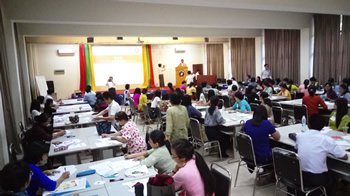Japanese Language is Spreading and Increasing in Myanmar
Yangon University of Foreign Languages
SATO Naoki
Myanmar, known for its large population of devout Buddhists, is located on the western edge of Southeast Asia, adjacent to Thailand, Laos, China, India, and Bangladesh. Myanmar is currently attracting international attention as it goes through a major transition from a military to democratic government.
The Japanese Wave is Coming
Japanese-language education in Myanmar has a history of 53 years, having become part of school curriculums in 1964, starting with the Yangon University of Foreign Languages, known as the Institute of Foreign Languages at the time. All universities in Myanmar are nationally operated, and the only schools at which Japanese can be learned are the Yangon University of Foreign Languages where I teach (hereinafter “YUFL”), and the Mandalay University of Foreign Languages (hereinafter “MUFL”).
The University offers four-year bachelors, masters programs, an associate degree program known as the Diploma Course, and nighttime courses for the general public, all of which have seen a rise in attendance in recent years.
This trend is occurring not only in Yangon, but also in Mandalay, Myanmar’s second largest city, and the number of new students attending the nighttime courses at the MUFL have exceeded 500. This is an increase of over 200% from last year, an increase that required raising the number of students in each class. This increasing interest in the Japanese language in Myanmar is also evident in the results of the Japan Foundation Survey on Japanese-Language Education Abroad.
It goes without saying that the increased entry of Japanese companies into the Myanmar market has had a major influence on this increase. Many students also learn Japanese in order to take advantage of employment opportunities in Japan, and there has been a significant rise in the number of Myanmar citizens traveling to Japan through the technical intern training program.
Myanmar Japanese-Language Teachers Network
The Japan Foundation and the Embassy of Japan in Myanmar co-host a Japanese-language education seminar twice per year. The seminar held in April 2017 saw major growth with the participation of 87 Japanese instructors from Yangon and 46 from Mandalay. In addition to the increase in Japanese-language learners, there has also been a remarkable increase in the number of Japanese-language educational institutions, with a three-fold increase from 44 to 132 institutions when comparing the Japan Foundation Survey on Japanese-Language Education Abroad between 2012 and 2015. There are few opportunities for Japanese-language teachers from different institutions to meet at once, making the seminars a valuable opportunity for networking.
There are also monthly study groups held by the Japanese Language Teacher Association, Myanmar, established mainly by Myanmar teachers of Japanese, and the Japanese Language Teacher Association, Yangon, comprised mainly of Japanese teachers who are Japanese citizens, as reported in the 2016 Japanese-Language Specialists’ Report. The Japanese group also has ongoing networking meetups over drinks. I hope that the teacher network will continue to expand around the seminars and Association seminars.

Scenes from the seminar in Yangon
Interest in Japanese Culture
The number of people with an interest in Japanese culture, such as Manga, Anime, Origami, Cosplay, and Kimono is also rising, and there is a sense that the image of Japan held by the Myanmar is diversifying. An Origami Club was founded by students at the YUFL last year with participation by many students from other departments in addition to the Japanese Language department. The presence of the NIHONGO Partners (hereinafter “NP”) deployed by the Japan Foundation Asia Center is also significant, and the opportunities to learn about Japanese culture directly from a Japanese person are apparently quite appealing.
Finally, the Japan Culture House, founded last year as a joint program of the Japan Foundation Asia Centerand the Myanmar Association of Japan Alumni, has seen a large number of visitors to its workshops, including Kirigami, Origami, Shodo (calligraphy), Yukata, and Ikebana (flower arranging), with the number of applicants greatly exceeding capacity every time.
I believe that interest in the Japanese language will continue to grow stronger in Myanmar. I hope to continue providing support to help meet the diversifying interests in Japan and the Japanese language.

Origami Club at YUFL
- What We Do Top
- Arts and Cultural Exchange [Culture]
- Japanese-Language Education Overseas [Language]
- Japanese-Language Education Overseas [Language] Top
- Learn Japanese-language
- Teach Japanese-language
- Take Japanese-Language Test
- Know about Japanese-language education abroad
- The Japanese-Language Institute, Urawa
- The Japanese-Language Institute, Kansai
- Japanese-Language Programs for Foreign Specified Skilled Worker Candidates
- Japanese Language Education for Japanese Children Resident Overseas and for the Descendants of Migrants
- Archives
- Japanese Studies and Global Partnerships [Dialogue]
- JF digital collection
- Other Programs / Programs to Commemorate Exchange Year
- Awards and Prizes
- Publications
